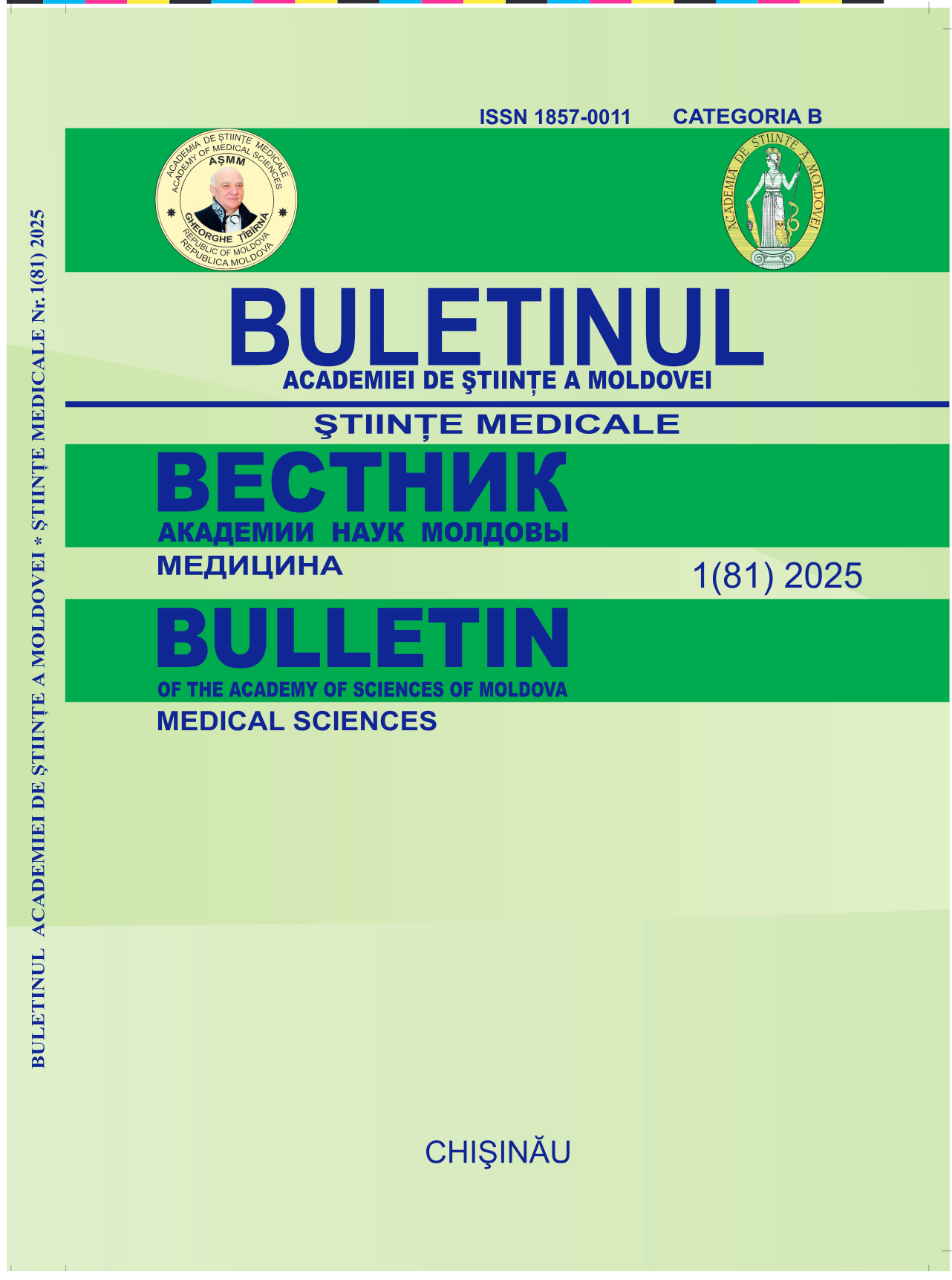Guideline for anthropometric examination of adults
DOI:
https://doi.org/10.52692/1857-0011.2025.1-81.21Keywords:
anthropometric parameters, body circumferences, obesityAbstract
According to the World Health Organization, overweight and obesity contribute to the development of type 2 diabetes in 44-57% of cases, ischemic heart disease in 17-23%, arterial hypertension in 17%, and other known pathologies. Estimates suggest that obesity increases the risk of cardiovascular mortality by four times and cancer-related mortality by two times [31].In this context, the current guideline provides a practical synthesis of key methods for assessing nutritional status and body composition, with applicability in clinical practice. It describes standardized techniques for direct measurements, relevant body circumferences, as well as indirect methods for estimating body composition. The guideline includes an updated table of the most commonly used anthropometric indices, highlighting their utility in obesity screening and cardiovascular risk prediction. The information is based on international recommendations and accompanied by validated clinical thresholds.This document aims to serve as a reference tool for clinicians in performing anthropometric assessments of adults within the context of cardiometabolic risk evaluation.
References
Centers for Disease Control and Prevention (CDC), National Center for Health Statistics (NCHS), National Health and Nutrition Examination Survey (NHANES). Anthropometry Procedures Manual. CDC, 2021.
Górnicka M, Szewczyk K, Białkowska A, Jancichova K, Habanova M, Górnicki K, Hamulka J. Anthropometric indices as predictive screening tools for obesity in adults. Appl. Sci., 2022; 12:6165.
Multi-Ethnic Study of Atherosclerosis Center. Manual of Operations. 2022; Version 11.
Best C, Shepherd E. Accurate measurement of weight and height 1: weighing patients. Nurs. Times, 2020; 116(4):50–52.
Du Bois D, Du Bois EF. A formula to estimate the approximate surface area if height and weight be known. Arch. Intern. Med., 1916; 17(6):863–871.
National Institutes of Health. The Practical Guide to the Identification, Evaluation and Treatment of Overweight and Obesity in Adults. NIH, Bethesda, 2000.
World Health Organization. Waist Circumference and Waist-Hip Ratio: Report of a WHO Expert Consultation. WHO, Geneva, 2008.
Ben-Noun LL, Laor A. Relationship between changes in neck circumference and cardiovascular risk factors. Exp. Clin. Cardiol., 2006; 11(1):14–20.
Roy NC. Use of mid-upper arm circumference for evaluation of nutritional status of children and for identification of high-risk groups for malnutrition in rural Bangladesh. J. Health Popul. Nutr., 2000; 18:171–180.
DAPA Toolkit. Diet, Anthropometry and Physical Activity Measurement Toolkit. https://dapa-toolkit.mrc.ac.uk (accessed 26 May 2022).
Tsai AC, Chang TL, Yang TW, Chang-Lee SN, Tsay SF. A modified mini nutritional assessment without BMI predicts nutritional status of community-living elderly in Taiwan. J. Nutr. Health Aging, 2010; 14:183–189.
Casadei K, Kiel J. Anthropometric Measurement. In: StatPearls [Internet]. Treasure Island (FL): StatPearls Publishing; 2024 Jan–. PMID: 30726000.
Azevedo FM, de Freitas Rocha AR, Morais DC, Ribeiro SAV, Gonçalves VSS, do Carmo Castro Franceschini S, Priore SE. Body fat is superior to body mass index in predicting cardiometabolic risk factors in adolescents. Int. J. Environ. Res. Public Health, 2023; 20:2074.
Lee DH, Keum N, Hu FB, et al. Development and validation of anthropometric prediction equations for lean body mass, fat mass and percent fat in adults. Br. J. Nutr., 2017; 118(10):858–866.
Wu LW, Lin YY, Kao TW, Lin CM, Liaw FY, Wang CC, Peng TC, Chen WL. Mid-arm muscle circumference as a significant predictor of all-cause mortality in male individuals. PLoS One, 2017; 12(2):e0171707.
Grodner M, Long S, DeYoung S. Nutrition in patient care. DeYoung S (ed). Foundations and Clinical Applications of Nutrition: A Nursing Approach. 3rd ed. Elsevier, 2004:406–407.
Lu Q, Wang R, Lou DH, Ma CM, Liu XL, Yin FZ. Mid-upper-arm circumference and arm-to-height ratio in evaluation of overweight and obesity in Han children. Pediatr. Neonatol., 2014; 55(1):14–19.
Bertoli S, Leone A, Krakauer NY, Bedogni G, Vanzulli A, Redaelli VI, De Amicis R, Vignati L, Krakauer JC. Association of Body Shape Index (ABSI) with cardio- metabolic risk factors: a cross-sectional study. PLoS One, 2017; 12(9):e0185013.
Thomas DM, Bredlau C, Bosy-Westphal A, Mueller M, Shen W, Gallagher D, Maeda Y, McDougall A, Peterson CM, Ravussin E, et al. Relationships between body roundness with body fat and visceral adipose tissue. Obesity, 2013; 21:2264–2271.
Zhang X, Ma N, Lin Q. Anthropometric predictors of health risk. JAMA Netw. Open, 2024; published online Jun 5.
Zierle-Ghosh A, Jan A. Physiology, Body Mass Index. In: StatPearls [Internet]. Treasure Island (FL): StatPearls Publishing; 2024 Jan–.
Gallagher D, Heymsfield SB, Heo M, Jebb SA, Murgatroyd PR, et al. Healthy percentage body fat ranges: an approach for developing guidelines based on BMI. Am. J. Clin. Nutr., 2000; 72:694–701.
Amato MC, Giordano C, Galia M, et al. Visceral adiposity index: a reliable indicator of visceral fat function associated with cardiometabolic risk. Diabetes Care, 2010; 33(4):920–922.
Amato MC, Giordano C. Visceral adiposity index: an indicator of adipose tissue dysfunction. Int. J. Endocrinol., 2014; 2014:730827.
Kouli GM, Panagiotakos DB, Kyrou I, et al. Visceral adiposity index and 10-year cardiovascular disease incidence: the ATTICA Study. Nutr. Metab. Cardiovasc. Dis., 2017; 27(10):881–889.
Amato MC, Giordano C, Pitrone M, Galluzzo A. Cut- off points of the visceral adiposity index identifying a visceral adipose dysfunction associated with cardiometabolic risk in a Caucasian cohort. Int. J. Endocrinol., 2014; 2014:730827.
World Health Organization. Waist circumference and waist–hip ratio: Report of a WHO expert consultation. Geneva, 2008.
Mørkedal B, Romundstad PR, Vatten LJ. Informativeness of indices of blood pressure, obesity and serum lipids in relation to ischaemic heart disease mortality: the HUNT-II study. Eur. J. Epidemiol., 2011; 26(6):457–464.
Lee CM, Huxley RR, Wildman RP, Woodward M. Indices of abdominal obesity are better discriminators of cardiovascular risk factors than BMI: a meta- analysis. J. Clin. Epidemiol., 2008; 61(7):646–653.
National Institute for Health and Care Excellence (NICE). Obesity: Identification and Classification of Overweight and Obesity (update). NICE, 2022.
Protocol clinic Național. Obezitatea la adult. Ediția I. PCN-424, Chișinău, 2023.
Downloads
Published
License
Copyright (c) 2025 Bulletin of the Academy of Sciences of Moldova. Medical Sciences

This work is licensed under a Creative Commons Attribution 4.0 International License.



